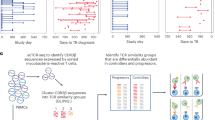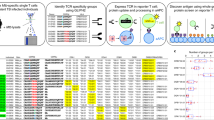Abstract
Elucidating the cellular immune response to infectious agents is a prerequisite for understanding disease pathogenesis and designing effective vaccines. In the identification of microbial T-cell epitopes, the availability of purified or recombinant bacterial proteins has been a chief limiting factor. In chronic infectious diseases such as Lyme disease, immune-mediated damage may add to the effects of direct infection by means of molecular mimicry to tissue autoantigens. Here, we describe a new method to effectively identify both microbial epitopes and candidate autoantigens. The approach combines data acquisition by positional scanning peptide combinatorial libraries and biometric data analysis by generation of scoring matrices. In a patient with chronic neuroborreliosis, we show that this strategy leads to the identification of potentially relevant T-cell targets derived from both Borrelia burgdorferi and the host. We also found that the antigen specificity of a single T-cell clone can be degenerate and yet the clone can preferentially recognize different peptides derived from the same organism, thus demonstrating that flexibility in T-cell recognition does not preclude specificity. This approach has potential applications in the identification of ligands in infectious diseases, tumors and autoimmune diseases.
This is a preview of subscription content, access via your institution
Access options
Subscribe to this journal
Receive 12 print issues and online access
$209.00 per year
only $17.42 per issue
Buy this article
- Purchase on Springer Link
- Instant access to full article PDF
Prices may be subject to local taxes which are calculated during checkout




Similar content being viewed by others
References
Germain, R.N. MHC-dependent antigen processing and peptide presentation: providing ligands for T lymphocyte activation. Cell 76, 287 –299 (1994).
Walden, P. T-cell epitope determination. Curr. Opin. Immunol. 8, 68–74 (1996).
Haass, A. Lyme neuroborreliosis. Curr. Opin. Neurol. 11, 253–258 (1998).
Sigal, L.H. Lyme disease: a review of aspects of its immunology and immunopathogenesis. Annu. Rev. Immunol. 15, 63– 692 (1997).
Sigal, L.H. Immunologic mechanisms in Lyme neuroborreliosis: the potential role of autoimmunity and molecular mimicry. Semin. Neurol. 17, 63–68 (1997).
Gross, D.M. et al. Identification of LFA-1 as a candidate autoantigen in treatment- resistant Lyme arthritis. Science 281, 703 –706 (1998).
Pinilla, C., Appel, J.R., Blanc, P. & Houghton, R.A. Rapid identification of high affinity peptide ligands using positional scanning synthetic peptide combinatorial libraries. Biotechniques 13, 901–905 (1992).
Hemmer, B. et al. The use of soluble synthetic peptide combinatorial libraries to determine antigen recognition of T-cells. J. Pept. Res. 52, 338–345 (1998).
Moretta, A., Pantaleo, G., Moretta, L., Cerottini, J.C. & Mingari, M.C. Direct demonstration of the clonogenic potential of every human peripheral blood T-cell. Clonal analysis of HLA-DR expression and cytolytic activity. J. Exp. Med. 157 , 743–754 (1983).
Yssel, H. et al. Borrelia burgdorferi activates a T helper type 1-like T-cell subset in Lyme arthritis. J. Exp. Med. 174, 593–601 (1991).
Yamamoto, K. et al. Establishment and application of a novel T-cell clonality analysis using single-strand conformation polymorphism of T-cell receptor messenger signals. Hum. Immunol. 48, 23– 31 (1996).
Illes, Z. et al. Identification of autoimmune T-cells among in vivo expanded CD25+ T-cells in multiple sclerosis. J. Immunol. 162, 1811–1187 (1999).
Hemmer, B., Vergelli, M., Pinilla, C., Houghten, R. & Martin, R. Probing degeneracy in T-cell recognition using combinatorial peptide libraries. Immunol. Today 19, 163–168 (1998).
Fraser, C.M. et al. Genomic sequence of a Lyme disease spirochaete, Borrelia burgdorferi. Nature 390, 580–586 (1997).
Hemmer, B. et al. Identification of high potency microbial and self ligands for a human autoreactive class II-restricted T-cell clone. J. Exp. Med. 185, 1651–1659 (1997).
Hemmer, B. et al. Predictable TCR antigen recognition based on peptide scans leads to the identification of agonist ligands with no sequence homology. J. Immunol. 160, 3631– 3636 (1998).
Hemmer, B., Stefanova, I., Vergelli, M., Germain, R.N. & Martin, R. Relationships among TCR ligand potency, thresholds for effector function elicitation, and the quality of early signaling events in human T-cells. J. Immunol. 160, 5807–5814 (1998).
Oksi, J. et al. Inflammatory brain changes in Lyme borreliosis. A report on three patients and review of literature. Brain 119, 2143–2154 (1996).
Garcia-Monco, J.C. & Benach, J.L. Mechanisms of injury in Lyme neuroborreliosis. Semin. Neurol. 17, 57–62 (1997).
Steere, A.C., Dwyer, E. & Winchester, R. Association of chronic Lyme arthritis with HLA-DR4 and HLA-DR2 alleles. N. Engl. J. Med. 323, 219 –223 (1990).
Lengl-Janssen, B., Strauss, A.F., Steere, A.C. & Kamradt, T. The T helper cell response in Lyme arthritis: differential recognition of Borrelia burgdorferi outer surface protein A in patients with treatment-resistant or treatment-responsive Lyme arthritis. J. Exp. Med. 180, 2069–2078 (1994).
Kamradt, T., Lengl-Janssen, B., Strauss, A.F., Bansal, G. & Steere, A.C. Dominant recognition of a Borrelia burgdorferi outer surface protein A peptide by T helper cells in patients with treatment-resistant Lyme arthritis. Infect. Immun. 64, 1284–1289 (1996).
Martin, R., Ortlauf, J., Sticht-Groh, V., Bogdahn, U., Goldmann, S.F., & Mertens H.G. Borrelia burgdorferi-specific and autoreactive T-cell lines from cerebrospinal fluid in Lyme radiculomyelitis. Ann. Neurol . 24, 509–516 (1988).
Akin, E., McHugh, G.L., Flavell, R.A., Fikrig, E. & Steere, A.C. The immunoglobulin (IgG) antibody response to OspA and OspB correlates with severe and prolonged Lyme arthritis and the IgG response to P35 correlates with mild and brief arthritis. Infect. Immun. 67, 173–181 (1999).
Fikrig, E. et al. Borrelia burgdorferi P35 and P37 proteins, expressed in vivo, elicit protective immunity. Immunity 6, 531–539 (1997).
Oschmann, P., Wellensiek, H.J., Zhong, W., Dorndorf, W. & Pflughaupt, K.W. Relationship between the Borrelia burgdorferi specific immune response and different stages and syndromes in neuroborreliosis. Infection 25, 292– 297 (1997).
Padula, S.J., Sampieri, A., Dias, F., Szczepanski, A. & Ryan, R.W. Molecular characterization and expression of p23 (OspC) from a North American strain of Borrelia burgdorferi. Infect. Immun. 61, 5097–5105 (1993).
Lam, T.T., Nguyen, T.P., Fikrig, E. & Flavell, R.A. A chromosomal Borrelia burgdorferi gene encodes a 22-kilodalton lipoprotein, P22, that is serologically recognized in Lyme disease. J. Clin. Microbiol. 32, 876–883 (1994).
Kovats, S. et al. Coordinate defects in human histocompatibility leukocyte antigen class II expression and antigen presentation in bare lymphocyte syndrome. J. Exp. Med. 179, 2017– 2022 (1994).
Vergelli, M. et al. HLA-DR-restricted presentation of purified myelin basic protein is independent of intracellular processing. Eur. J. Immunol. 27, 941–951 (1997).
Mason, D. A very high level of crossreactivity is an essential feature of the T-cell receptor. Immunol. Today 19, 395– 404 (1998).
Gran, B., Hemmer, B., Vergelli, M., McFarland, H.F. & Martin, R. Molecular mimicry and multiple sclerosis: degenerate T-cell recognition and the induction of autoimmunity. Ann. Neurol. 45, 559–567 (1999).
Gross, D.M., Steere, A.C. & Huber, B.T. T helper 1 response is dominant and localized to the synovial fluid in patients with Lyme arthritis. J. Immunol. 160, 1022–1028 (1998).
Allen, M. et al. Association of susceptibility to multiple sclerosis in Sweden with HLA class II DRB1 and DQB1 alleles. Hum Immunol 39, 41–48 (1994).
Centers for Disease Control and Prevention. Recommendations for test performance and interpretation from the Second National Conference on Serologic Diagnosis of Lyme Disease. J. Am. Med. Assoc. 274, 937 (1995).
Pinilla, C., Appel, J.R. & Houghten, R.A. Investigation of antigen-antibody interactions using a soluble, non- support-bound synthetic decapeptide library composed of four trillion (4 × 10(12) sequences. Biochem. J. 301 , 847–853 (1994).
Houghten, R.A. General method for the rapid solid-phase synthesis of large numbers of peptides: specificity of antigen-antibody interaction at the level of individual amino acids. Proc. Natl. Acad. Sci. USA 82, 5131 –5135 (1985).
Martin, R. et al. Diversity in fine specificity and T-cell receptor usage of the human CD4+ cytotoxic T-cell response specific for the immunodominant myelin basic protein peptide 87-106. J. Immunol. 148, 1359–1366 (1992).
Reece, J.C., Geysen, H.M. & Rodda, S.J. Mapping the major human T helper epitopes of tetanus toxin. The emerging picture. J. Immunol. 151, 6175–6184 (1993).
Trueba, G.A., Old, I.G., Saint Girons, I. & Johnson, R.C. A cheA cheW operon in Borrelia burgdorferi, the agent of Lyme disease. Res. Microbiol. 148, 191–200 (1997).
Alekshun, M., Kashlev, M. & Schwartz, I. Molecular cloning and characterization of Borrelia burgdorferi rpoB. Gene 186, 227–235 (1997).
Bono, J.L., Tilly, K., Stevenson, B., Hogan, D. & Rosa, P. Oligopeptide permease in Borrelia burgdorferi: putative peptide-binding components encoded by both chromosomal and plasmid loci. Microbiology 144, 1033–1044 (1998).
Old, I.G., Margarita, D. & Saint Girons, I. Unique genetic arrangement in the dnaA region of the Borrelia burgdorferi linear chromosome: nucleotide sequence of the dnaA gene. FEMS Microbiol. Lett. 111, 109– 114 (1993).
Sprenger, H. et al. Borrelia burgdorferi induces chemokines in human monocytes. Infect. Immun. 65, 4384– 4388 (1997).
Yamamoto, Y. et al. Cloning and expression of myelin-associated oligodendrocytic basic protein. A novel basic protein constituting the central nervous system myelin. J. Biol. Chem. 269, 31725– 31730 (1994).
Labeit, S. & Kolmerer, B. Titins: giant proteins in charge of muscle ultrastructure and elasticity. Science 270 , 293–296 (1995).
Yamada, Y. et al. Cloning and functional characterization of a family of human and mouse somatostatin receptors expressed in brain, gastrointestinal tract, and kidney. Proc. Natl. Acad. Sci. USA 89, 251–255 (1992).
Derynck, R. et al. A new type of transforming growth factor-beta, TGF-beta 3. EMBO J. 7, 3737–3743 (1988).
Schweickart, V.L. et al. Cloning of human and mouse EBI1, a lymphoid-specific G-protein-coupled receptor encoded on human chromosome 17q12-q21.2. Genomics 23, 643–650 (1994).
Sallusto, F. et al. Rapid and coordinated switch in chemokine receptor expression during dendritic cell maturation. Eur. J. Immunol. 28, 2760–2769 (1998).
Sims, J.E. et al. Cloning the interleukin 1 receptor from human T-cells. Proc. Natl. Acad. Sci. USA 86, 8946– 8950 (1989).
Nanus, D.M. et al. Molecular cloning of the human kidney differentiation antigen gp160: human aminopeptidase A. Proc. Natl. Acad. Sci. USA 90, 7069–7073 (1993).
Li, L., Wang, J. & Cooper, M.D. cDNA cloning and expression of human glutamyl aminopeptidase (aminopeptidase A). Genomics 17, 657– 664 (1993).
Thomson, B.J., Efstathiou, S. & Honess, R.W. Acquisition of the human adeno-associated virus type-2 rep gene by human herpesvirus type-6. Nature 351, 78–80 (1991).
Pieniazek, N.J., Slemenda, S.B., Pieniazek, D., Velarde, J., Jr. & Luftig, R.B. Human enteric adenovirus type 41 (Tak) contains a second fiber protein gene. Nucleic Acids Res. 18, 1901 (1990).
Gao, F. et al. Molecular cloning and analysis of functional envelope genes from human immunodeficiency virus type 1 sequence subtypes A through G. The WHO and NIAID networks for HIV isolation and characterization. J. Virol. 70, 1651–1667 (1996).
Acknowledgements
We thank G. Subramanian (National Institute of Allergy and Infectious Diseases, National Institutes of Health) for help in identifying the peptide sequences. B.H. was supported in part by the Deutsche Forschungsgemeinschaft (He 2386/2-1). B.G. is supported by a Fogarty International Research Fellowship.
Author information
Authors and Affiliations
Corresponding authors
Rights and permissions
About this article
Cite this article
Hemmer, B., Gran, B., Zhao, Y. et al. Identification of candidate T-cell epitopes and molecular mimics in chronic Lyme disease. Nat Med 5, 1375–1382 (1999). https://doi.org/10.1038/70946
Received:
Accepted:
Issue Date:
DOI: https://doi.org/10.1038/70946
This article is cited by
-
Reconsideration of the Gastroparetic Syndrome
Current Gastroenterology Reports (2023)
-
The Gut Microbiome in Neuromyelitis Optica
Neurotherapeutics (2018)
-
Metal-specific CD4+ T-cell responses induced by beryllium exposure in HLA-DP2 transgenic mice
Mucosal Immunology (2016)
-
Lyme borreliosis
Nature Reviews Disease Primers (2016)
-
Ability to cause erythema migrans differs between Borrelia burgdorferi sensu lato isolates
Parasites & Vectors (2013)



